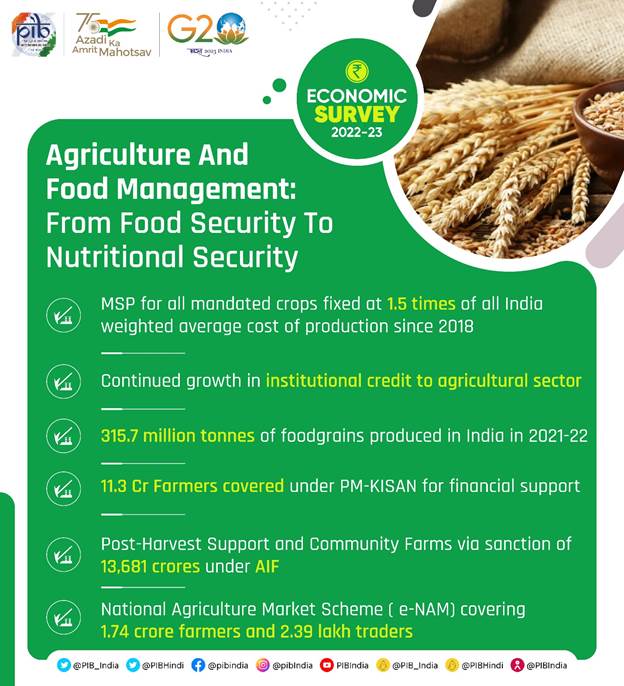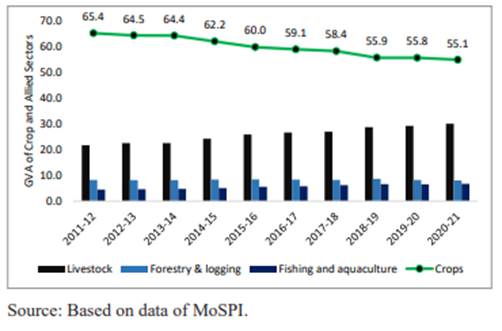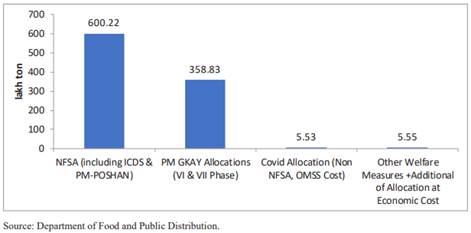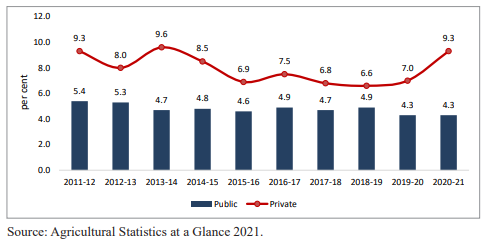Ministry of Finance
INDIA’S FOODGRAINS PRODUCTION TOUCHED A RECORD 315.7 MILLION TONNES IN 2021-22
RECORD PRODUCTION OF 342.3 MILLION TONNES OF HORTICULTURE PRODUCTS IN 2021-22
₹20,050 CRORE TO PRADHAN MANTRI MATSYA SAMPADA YOJANA
FREE FOODGRAINS TO ABOUT 81.35 CRORE BENEFICIARIES UNDER THE NATIONAL FOOD SECURITY ACT, 2013 FOR ONE YEAR FROM 1ST JANUARY 2023
ONE NATION ONE RATION CARD (ONORC) SCHEME ENABLED IN ALL STATES/UTs
₹13,681 CRORE SANCTIONED FOR AGRICULTURE INFRASTRUCTURE
MORE THAN 1.7 CRORE FARMERS AND 2.3 LAKH TRADERS HAVE BEEN REGISTERED ON E-NAM PORTAL
INDIA HAS MORE THAN 500 START-UPS WORKING IN THE MILLET VALUE CHAINS
प्रविष्टि तिथि:
31 JAN 2023 1:20PM by PIB Delhi
India’s foodgrains production touched a record 315.7 million tonnes in 2021-22 despite climate change challenges says the Economic Survey 2022-23 tabled in the Parliament by the Union Minister of Finance and Corporate Affairs Smt. Nirmala Sitharaman here today. Further, as per the First Advance Estimates for 2022-23 (Kharif only), total foodgrains production in the country is estimated at 149.9 million tonnes which is higher than the average Kharif foodgrain production of the previous five years (2016-17 to 2020-21). The production of pulses has also been notably higher than the average of 23.8 million tonnes in the last five years points the Survey.

Mission for Integrated Development of Horticulture (MIDH)
The Survey describes, Horticulture as a “high growth area” and “a source of buoyant growth and improved resilience for farmer”. According to third advance estimates (2021-22), a record production of 342.3 million tonnes in an area of 28.0 million hectares was achieved. The Government has identified 55 horticulture clusters, of which 12 have been selected for the Cluster Development Programme (CDP) pilot phase. MIDH is designed to leverage the geographical specialisation of horticulture clusters, promote integrated and market-led development of pre-production, production and post-harvest activities across the entire supply chain.
Animal Husbandry, Dairying and Fisheries
The allied sectors of Indian agriculture - livestock, forestry & logging and fishing & aquaculture are gradually becoming sectors of robust growth and a potential source of better farm incomes says the Survey.

The livestock sector grew at a CAGR of 7.9 per cent during 2014-15 to 2020-21 (at constant prices), and its contribution to total agriculture GVA (at constant prices) has increased from 24.3 per cent in 2014-15 to 30.1 per cent in 2020-21. Similarly, the annual average growth rate of the fisheries sector has been about 7 per cent since 2016-17 and has a share of about 6.7 per cent in the total agricultural GVA. The dairy sector which employs more than eight crore farmers directly is critical along with products like eggs and meat. India ranks first in milk production in the world, it ranks third in egg production and eighth in meat production in the world points the Survey.
Cognisant of the importance of the allied sectors, the Government has made multiple interventions to enhance the infrastructure, improve productivity and disease control. Under, Animal Husbandry Infrastructure Development Fund, 116 projects have been approved with total cost of ₹3,731.4 crore. The scheme was launched with a total allocation of ₹15,000 crore. While the National Livestock Mission lays emphasis on breed development and entrepreneurship development, the Livestock Health & Disease Control Scheme is being implemented to prevent control and contain animal diseases of economic and zoonotic importance and the National Animal Disease Control Programme is being implemented to control Foot & Mouth Disease and Brucellosis.
Pradhan Mantri Matsya Sampada Yojana (PMMSY), with a total outlay of ₹20,050 crore. PMMSY marks the highest-ever investment in the fisheries sector in India, to be implemented over five years from FY21 to FY25 across the country to drive sustainable and responsible development of the fisheries sector while ensuring socio-economic development of the fishers, fish farmers and fish workers. Under a dedicated Fisheries and Aquaculture Infrastructure Development Fund (FIDF), proposals to the tune of ₹4,923.9 crore have been approved and have benefitted over 9.4 lakh persons, through direct and indirect employment, in fishing and allied activities as on 17th October 2022.
Food Security
The Survey describes that the food management programme in India comprises procurement of food grains from farmers at remunerative prices, distribution of food grains to consumers, particularly the vulnerable sections of society, at affordable prices and maintenance of food buffer stock for food security and price stability. The Government in a recent decision has decided to provide free foodgrains to about 81.35 crore beneficiaries under the National Food Security Act (NFSA), 2013 for one year from 1st January 2023. Further, to remove the financial burden of the poor, the government will spend more than ₹2 lakh crore in this period on food subsidies under NFSA and other welfare schemes says the Survey. During Kharif Marketing Season (KMS) 2021-22, 581.7 lakh metric tons (LMT) of Rice was procured against an estimated target of 532.7 LMT. In the current year, KMS 2022-23, a total of 355 LMT of rice has been procured up to 31 December 2022.

Under the PM Garib Kalyan Anna Yojana, the Government allocated about 1,118 LMT foodgrains to the States/UTs to ease the hardships faced by the poor during the COVID-19 pandemic. To further ease the process of access to food, the Government launched a citizen-centric and technology-driven scheme in 2019 called the One Nation One Ration Card (ONORC) scheme. The ONORC system enables intra-State and inter-State portability of ration cards. Presently, the national/inter-State portability is enabled in all 36 States/UT, covering 100 per cent of the total NFSA population.
International Year of Millets
The United Nations General Assembly, in its 75th session during March 2021, declared 2023 the International Year of Millets (IYM). India produces more than 50.9 million tonnes (as per fourth advance estimate) of millet which accounts for 80 per cent of Asia’s and 20 per cent of global production. The global average yield is 1229 kg/ha, whereas India has a higher average yield of 1239 kg/ha. Given the nutritional value of the millets, the Government notified Millets as Nutri-cereals in April 2018. Under the National Food Security Mission (NFSM), millets have been introduced to provide nutritional support. A sub-mission on Nutri-cereals is being implemented since 2018-19 in 212 districts of 14 States. India has more than 500 start-ups working in the millet value chains.
Food Processing Sector
Over the last five years ending FY21, the food processing industries sector has been growing at an average annual growth rate of around 8.3 per cent. The food processing sector is of enormous significance for India's development because of the strong connections and interactions it promotes between industry and agriculture. The value of agri-food exports, including processed food exports, was about 10.9 per cent of India's total exports during 2021-22 points the Survey.
Recognising the abundant potential of the sector, the Government has been at the forefront with various interventions aimed at the development of food processing in the country. Through the component schemes of Pradhan Mantri Kisan SAMPADA Yojana (PMKSY), for the overall growth and development of the food processing sector, 677 projects have been completed till 31 December 2022. Further, under the Prime Minister's Formalisation of Micro Food Processing Enterprises (PMFME) Scheme to enhance the competitiveness of individual micro-enterprises in the unorganised segment and promote the formalisation of this sector, as of 31 December 2022, 15,095 loans of ₹1402.6 crore were sanctioned. The scheme adopts One District, One product (ODOP) approach to reap the benefit of scale in procuring inputs, using shared services and marketing products. So far, 713 Districts with 137 unique products were approved under the ODOP in 35 States/ UTs. The Production Linked Incentive Scheme for Food Processing Industry (PLISFPI), launched in March 2022, has the specific mandate to incentivise investments to create global food champions. Sectors with high growth potential, like marine products, processed fruits & vegetables, and ‘Ready to Eat/ Ready to Cook’ products, are covered for support points the Survey.
Agriculture Infrastructure Fund (AIF)
The NITI Aayog Strategy for New India identifies the lack of adequate and efficient cold chain infrastructure as a critical supply-side bottleneck that leads to massive post-harvest losses (mostly of perishables) estimated at ₹92,561 crore annually. To tackle this and unlock the growth potential of the agriculture and allied sector, the Government introduced AIF. It is a financing facility operational from the year 2020-21 to 2032-33 for the creation of post-harvest management infrastructure and community farm assets, with benefits including 3 per cent interest subvention and credit guarantee support. Since its inception, an amount of ₹13,681 crore has been sanctioned for agriculture infrastructure in the country, covering more than 18,133 projects. These include 8,076 warehouses, 2,788 primary processing units, 1,860 custom hiring centres, 937 sorting & grading units, 696 cold store projects, 163 assaying units and around 3613 other kinds of post-harvest management projects and community farming assets.

National Agriculture Market (e-NAM)
As on 31 December 2022, more than 1.7 crore farmers and 2.3 lakh traders have been registered on e-NAM portal. The scheme was launched to create an online transparent, competitive bidding system to ensure farmers get remunerative prices for their produce Under the e-NAM Scheme, the Government provides free software and assistance of ₹75 lakh per APMC mandi for related hardware, including quality assaying equipment and the creation of infrastructure like cleaning, grading, sorting, packaging, compost unit, etc.
The Survey observes that the performance of the agriculture sector remains critical to growth and employment in the country. Investment in the sector must be encouraged through an affordable, timely and inclusive approach to credit delivery. A focus on the horticulture sector and the thrust towards allied activities have diversified farmers’ income making them more resilient to weather shocks. All these initiatives have led to sustainable and inclusive development of the sector.
***
RM/NR/KAK
(रिलीज़ आईडी: 1894899)
आगंतुक पटल : 25804